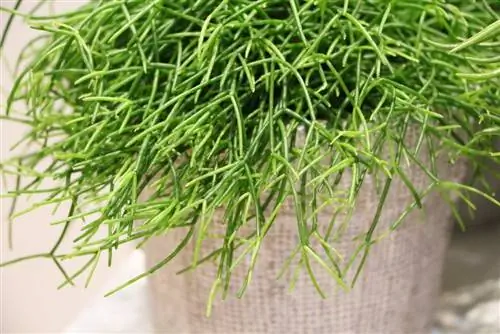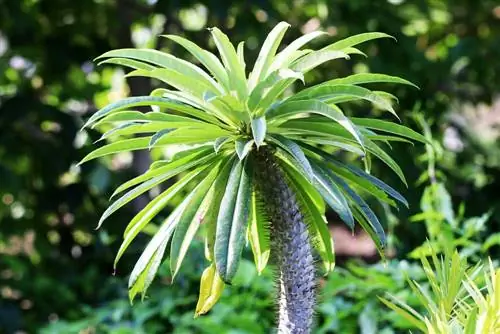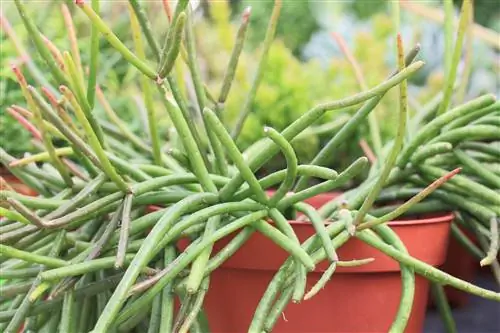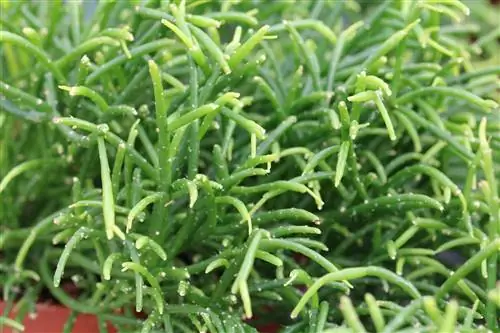- Author admin [email protected].
- Public 2023-12-17 03:39.
- Last modified 2025-01-24 12:45.
The coral cactus belongs to the cactus family, even if its external appearance is rather atypical for a cactus. The shoots of this plant, up to 30 cm high, can grow up to a meter long and take on a reddish color in the sun. They usually only develop flowers when they are older. Rhipsalis cassutha is the perfect hanging plant and is also very popular with terrarium enthusiasts.
Is Rhipsalis cassutha poisonous?
Even if it is not sufficiently clear whether this plant is poisonous, according to experts it should not contain any toxins. It is said to pose no danger to humans or cats. Their supposed toxicity comes from the fact that Rhipsalis cassutha is often confused with the spurge family. They contain a poisonous, milky juice.
However, the coral cactus is not a member of the spurge family and does not contain milky sap, but stored water. If you still want to be on the safe side, you should avoid these plants and not leave cut parts of the plants lying around. Cat owners should place this cactus where it is out of reach of pets.
Coral Cactus Care Instructions
Like most species of its genus, the rod cactus is very undemanding when it comes to location and care. It forgives one or two care mistakes without any problems, which makes it an ideal starter plant.
Location
Rhipsalis cassutha belongs to a genus of epiphytic cacti from the rainforests of Brazil. Accordingly, it needs a warm and bright to partially shaded place in the living room at home with some sun in the morning and evening. Bright sun during the midday hours should be avoided as it could cause burns. The plant thrives all year round at normal room temperatures.
It is ideal in a flower window facing east or west. Shading is essential in a south-facing window. During the warm season it can also be kept outdoors in a sheltered, partially shaded to sunny spot. According to its natural origin, the coral cactus is grateful for increased humidity.
Tip:
Larger temperature differences between day and night of around 10 degrees as well as a cooler location in winter are said to have a positive effect on flower formation.
Floor
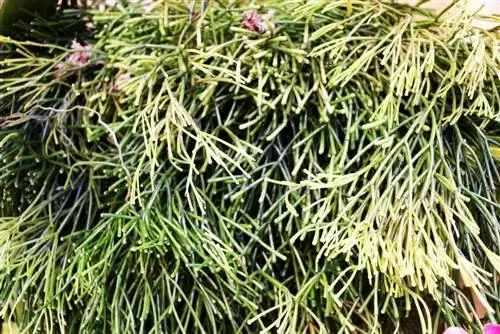
The right soil also contributes to he althy growth. Above all, it should be permeable, medium coarse, humic and nutritious. Accordingly, a commercially available green plant soil mixed with high-quality cactus soil is ideal for epiphytes. Cactus soil with coarse components such as clay granules, pumice gravel or pine bark, which is often used for orchids, is ideal. Alternatively, ready-made substrates for epiphytic orchids can be used. You should avoid calcareous substrates.
Pouring
The water requirements of this bizarre beauty are moderate. The soil should neither dry out nor be permanently wet. Shorter dry periods are usually survived without suffering any damage.
- Water once a week in spring and summer
- Allow the top substrate layer to dry thoroughly before each watering
- Reduce watering from September until flowering in November
- Water a little more during flowering
- Ensure a humidity level of at least 50 to 70%
- To do this, spray plants regularly with lime-free water
- Occasional showering recommended
- This removes the dust and brings the cactus back to life
Due to its intolerance to lime, you should only use lime-free water, ideally rainwater, for both watering and spraying. If this is not possible, softened tap water will also work.
Tip:
Excess irrigation water in saucers should be removed as quickly as possible, the coral cactus doesn't like wet feet.
Fertilize
The rod cactus is also very frugal when it comes to nutrient requirements, even if it needs a little more nutrients than most other types of cactus. In the first year after purchase or after repotting, fertilizer can be dispensed with. Ready-made substrates are usually pre-fertilized so that the plants are supplied with all the important nutrients for the first time.
You should fertilize regularly later. It is completely sufficient to administer a high-quality cactus fertilizer once a month from April to September/October. This ensures that the shoots develop a firm structure. You fertilize this cactus while the buds are forming and stop fertilizing as soon as the first flower buds open. Only after flowering is normal fertilization resumed.
Cutting
Over time, Rhipsalis cassutha develops a bushy habit and long, overhanging shoots. The coral cactus usually does not need pruning. Nevertheless, it is very tolerant of pruning and can be cut back without any problem if it has grown too lushly. Its shoots can be shortened by up to two thirds. The best time for this is in spring. It is best to always cut where a shoot ends. Dry and damaged plant parts can also be removed. The he althy cuttings can be used very well for propagation.
Wintering
Rhipsalis cassutha does not go into a real rest period, it can be kept at normal room temperatures all year round. If it has been left outside over the summer, it will be time to move into the house around September. Some experts recommend keeping this plant a little cooler in winter than the rest of the year. This is intended to stimulate flower formation. We are talking about temperatures between 12 and 15 degrees from around September to the beginning of November, without direct sunlight.
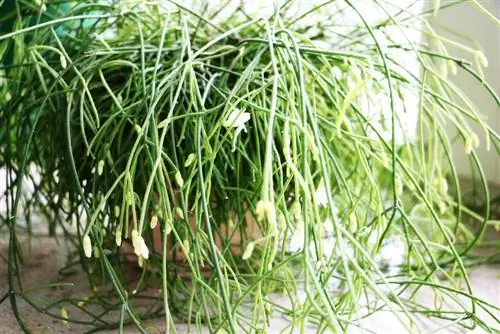
From November onwards, the coral cactus can be a little warmer again, at around 20 degrees, then it is blooming time. The plant should not be placed directly next to a heater in winter. Only a little is watered, although the substrate should not dry out completely even in winter. To ensure high humidity, occasional spraying is advisable. Alternatively, you can place bowls filled with water around the room. Fertilization is not carried out in winter or during flowering.
Repotting
The root growth is limited, so it doesn't have to be repotted every year. However, important properties of the substrate are lost over time, so repotting is advisable about every 2-3 years. This is possible in spring and autumn, but preferably in March/April.
- Carefully remove the cactus from the pot
- Carefully shake off old soil
- Damage the roots as little as possible
- Remove diseased and dead root parts
- Due to the small roots, a larger pot is usually not required
- Clean old pot thoroughly
- Then fill with fresh, well-drained substrate
- Insert plant in the middle
- Press the soil lightly and water it
Depending on the location, it may be advisable to rotate the plant regularly so that sufficient light reaches all sides and uniform growth can develop.
Tip:
The coral cactus feels most comfortable in clay pots. They have the decisive advantage over plastic that water can evaporate through the naturally porous material.
Propagate
The rod cactus can be propagated both by cuttings and by sowing, with cutting-link propagation being the more uncomplicated variant of the two. Sowing is usually only promising with fresh seeds and germinable seeds are difficult to obtain.
Cuttings
Cuttings for propagation can, for example, be obtained during an upcoming pruning. Otherwise you can cut them from the mother plant in spring or autumn.
- Cuttings should be about 10-15 cm long
- After cutting, leave the interfaces to dry in a cool place for 1-2 days
- Then fill small pots with growing substrate
- Pure Seramis is well suited
- Failures can occur in conventional soil
- Insert 3-4 cuttings approx. 3-4 cm deep into the substrate
- Slightly moisten the substrate
- Place in a warm and bright to partially shaded, but not sunny place
- Keep slightly moist for the next 3-4 weeks
Several cuttings per pot have the advantage of achieving bushier and denser growth more quickly. Temperatures around 20 degrees and high humidity are conducive to rapid rooting. This can be achieved by putting a translucent foil bag over it. To prevent mold from forming, the film must be removed and ventilated once a day. If the first new shoot members appear, the rooting has been successful. The film can be removed and the young plants can be cultivated normally.
Sowing
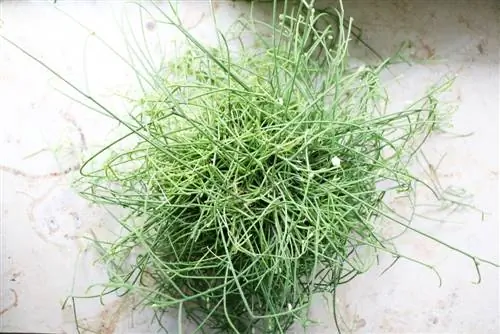
If you can get fresh seeds, you can try sowing them. First you need appropriate growing material consisting of a growing container, growing soil, preferably cocohum, and of course the seeds. If the cultivation container is filled with cocohumer, the seeds are distributed evenly and the whole thing is moistened.
Then cover the container with cling film to ensure sufficient humidity and place it in a warm and bright to sunny place, again without direct sunlight. Temperatures between 20 and 28 degrees are required for germination. The substrate must be kept evenly moist until germination.
Diseases and pests
With the right care you can support the plant well and keep it alive for a long time, but there are also other problems.
Root rot
Rhipsalis cassutha is relatively insensitive to diseases. The only thing that can be dangerous for this plant is too much moisture. It can very quickly lead to root rot and thus death. To prevent this, you should only water in moderation and remove excess water in the saucer promptly. In order to possibly save endangered plants, they should be repotted into drier substrate as quickly as possible, removing rotten root parts and initially refraining from watering completely.
Mealybugs
Dry room air is usually responsible for mealybug infestations. These pests can be recognized by the fine white webs similar to cotton balls that cover the plant. These animals also leave behind sticky honeydew, which is their excrement. If an infestation is discovered, infected plants are first isolated to avoid spreading to he althy plants.
To combat it, you can treat the plants with a mixture of one liter of water and 15 ml each of spirit and curd soap or paraffin oil. Either you spray or coat them with it. As a rule, the whole thing has to be repeated several times. The additional use of lacewing larvae can also be helpful.
Scale insects
Infestation with scale insects can often be observed in coral cactus. You can recognize them, among other things, by their small brownish plates. Bright discolorations on affected plants can indicate an advanced infestation. If it is recognized too late, the cactus may die. In the event of an initial infestation, the pests can be collected or combated with a solution of water, soft soap and alcohol, which is dabbed or brushed on the pests several times. In addition, the use of natural predators such as parasitic wasps is possible.

